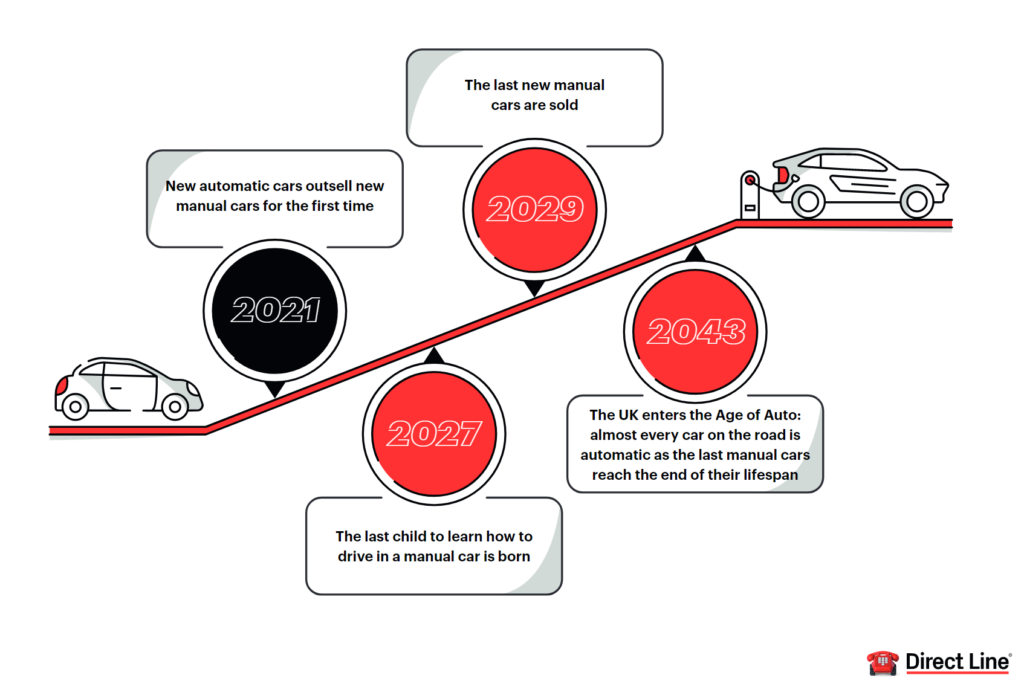Automatics for the people
Manual motors are approaching he end of the road
The UK is heading towards an age of automatic cars.
Analysis by Direct Line Motor Insurance suggests the upcoming ban on petrol and diesel engines will disengage the manual gearbox. The report concludes that the last person to take their driving test in a manual car could be born in just five years’ time.
The ban bonus
2030 will witness the ban on the sale of new combustion engine cars. They are to be replaced principally by electric vehicles (EVs) that do not require a clutch. EVs normally run in fixed forward gear, with Reverse being the only other option.
It means that there will be a rapid shift to automatic cars, and the transition is already well underway.
The average lifespan of a car is around 14 years according to the statistics. With the last new combustion engine cars being sold in 2029, it is likely to be scrapped by 2043. This, in turn, means that the last 17-year-olds learning to drive in a manual gearbox car will be born at some point during 2027.
And they’re off…
The research reveals that motorists are already starting to shift to an automatic world. Whilst it has been discussed for many years, the general move has been relatively slow. However, with the increasing popularity of the EV, more and more drivers are embracing the simpler life of automatics. This is not just older experienced motorists. Young people and learner are increasingly seeing the future as electric, and therefore automatic. Fewer and fewer people are taking their driving test in a car with a clutch and stick shift gearbox.
Research shows the share of tests taken in an automatic vehicle rose to 42% of all driving tests in 2020/21. More than half of the 2.2 million people who learnt to drive in an automatic car (55% or 1.2 million) are aged under 35, highlighting the shift away from manual cars in recent years.
The facts
Currently, manual cars still account for 70% of the 31.7 million cars on UK’s roads. However, last year over half (54%) of new cars sold in Britain were automatic, compared to around 20% a decade ago.
Further research by Direct Line reveals that the rise in electric cars, accelerating the shift to an automatic age of driving, is being spearheaded by younger people. Half of all electric vehicles currently on the road are owned by people aged under 35. These cars accounting for 41% of all automatic cars driven by this age group, compared to just 13% of those aged 35 or over.
Looking ahead, 8.6 million motorists (22%) expect to switch to an electric vehicle by 2030, due to the phasing out of the sale of new petrol and diesel cars. Around 11.4 million motorists (29%) expect to switch following the ban, probably in line with whenever they need to replace their existing car.
Key dates as UK motorists approach the Age of

Source: Direct Line Motor Insurance, 2022
Evolution
Ian Exworth is Director of Emerging Markets at Direct Line. He states that the evolution of the automatic transmission is well underway and unstoppable.
“There is no doubt that the ban on petrol and diesel cars will change the face of motoring in the UK, and one significant side effect of this is a rise in automatic cars. With a hard deadline in place, it is no surprise to see that motorists are already shifting their habits, with more people opting to learn in an automatic and moving away from manual gearboxes.
“The idea of switching from a manual car may be daunting, and nearly three fifths of motorists do not feel entirely confident about switching to automatic. But with eight years to go until the ban comes into effect; we’d encourage motorists to keep an open mind and explore their options when choosing a new car. The change from manual to automatic, and then on to electric, may not be as drastic as people think.”
Changing gear
Currently, the UK remains strictly bound by long term rules about learning to drive in automatics or manual, and what a full licence permits a driver to drive. If you take your driving test in an automatic vehicle, then you are not licenced to drive and manual vehicle. The only way to ammend this is to take a full driving test in a manual vehicle.
However, across much of Europe, licenced drivers can undergo a short supervised course with a driving instructor. Having completed the lesson and being signed off by the professional driver trainer, driving licences can be amended to include driving manual vehicles.
The DVSA has been under pressure for a number of years to introduce a similar system in the UK. Whilst there has, at times, been some positive noises on the subject, there have been no formal policy changes announced as of yet. However, the reality of a changing transport landscape may overtake events.





